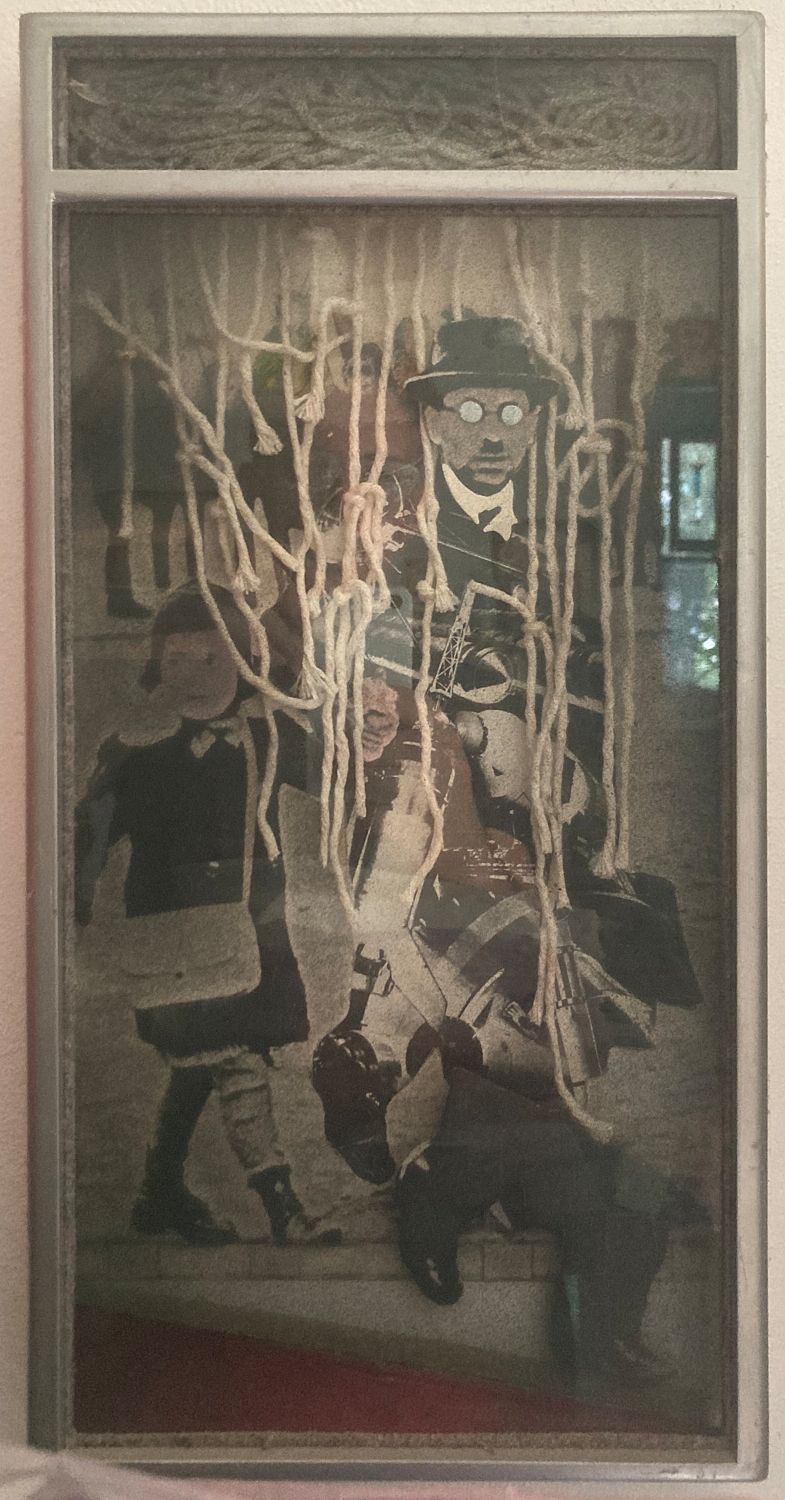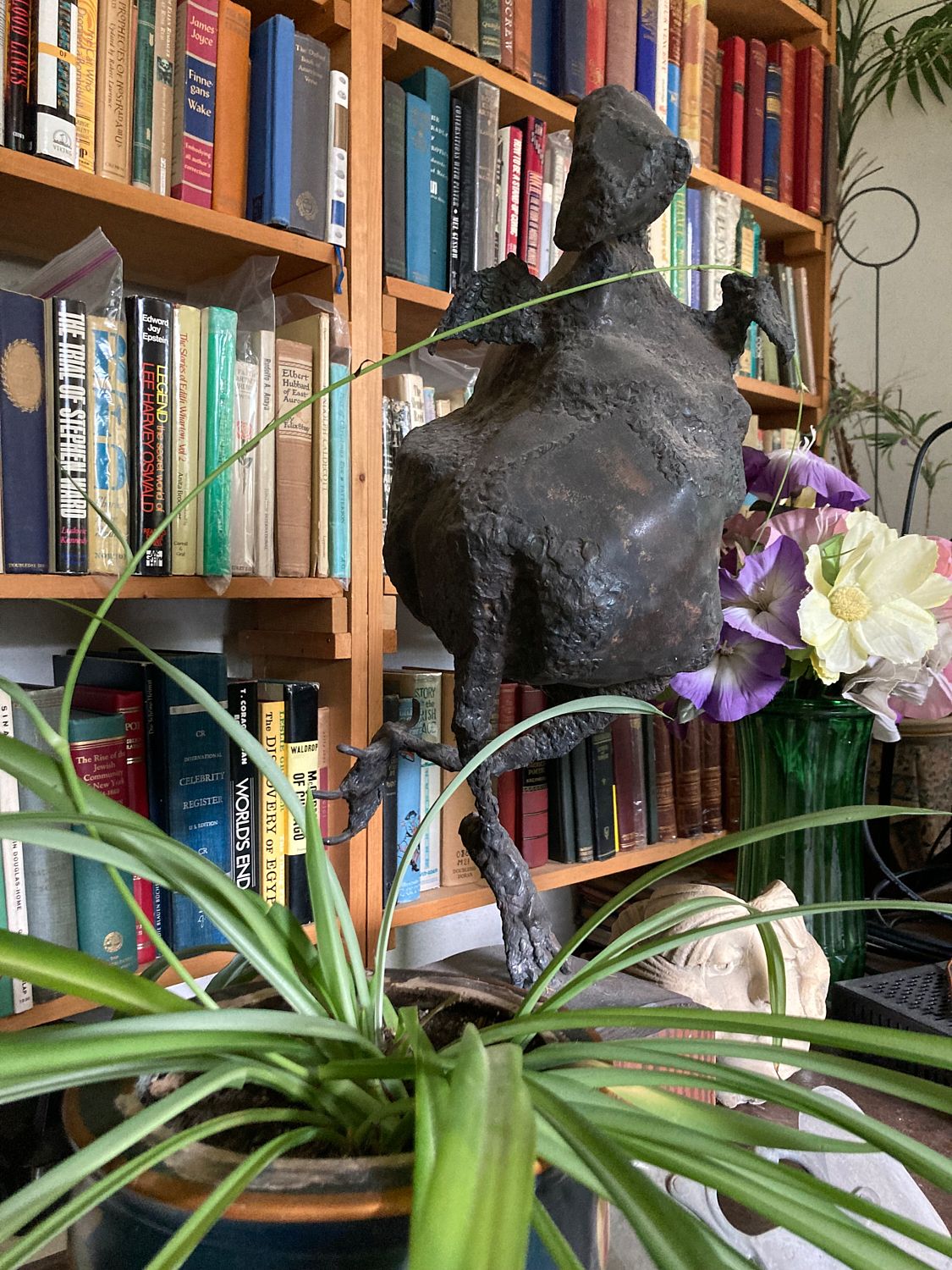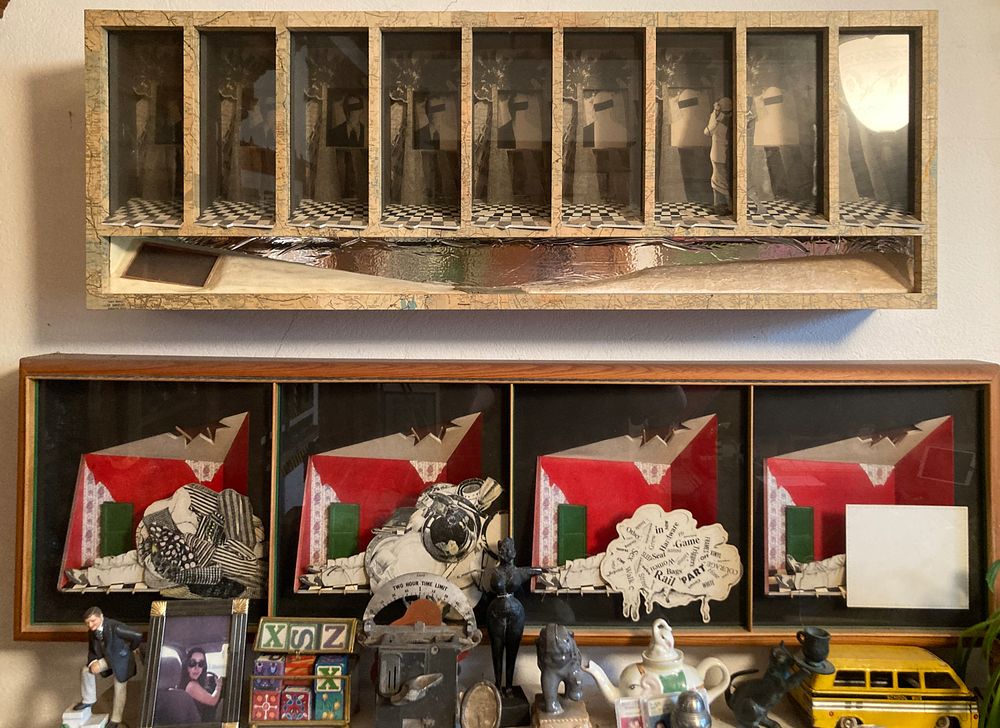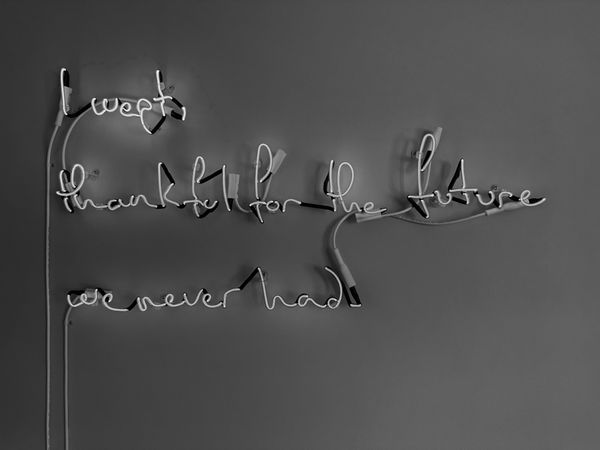Artist Incognito: An Interview with Dennis Bauer
by Cristian Andersson
Walking into the home to have this conversation with artist Dennis Bauer was filled with nostalgia. Filled floor-to-ceiling bookshelves–which at one point overflowed into stacks of books in the halls, the staircase, and lined the perimeters of the rooms. Dennis’ artwork: dark gray metal sculptures of bird-like entities that could be viewed as playful or tortured; surrealistic assemblages nestled within an overabundance of Americana bric-a-brac; and drawings–humorous, dark, sexual. Missing was the smell of smoked meat drifting over from Jacob’s Meat Market. And, I am no longer in my youth, visiting my friends. Instead, I am gray and about to enjoy a long conversation with their father.
Dennis relates to me when the family, back in ‘68, took their turn at the “Return to Earth Movement,” with the idea of moving from Chicago to a large farm outside of Rhinelander, Wisconsin. Ten rooms, 1,500 acres, and, after one winter, the realization that they were city people. The family found themselves in Appleton after some time in Wausau. I related my own family’s journey from Kenosha to Appleton. “This is the magnet, I guess,” Dennis commented on Appleton. “There’s always been something simmering under the city… something good, at least,” I replied.
“Well, when we first came here, we didn’t think it was too exciting a place,” Dennis mused. “I got a job teaching [at the Extension, now known as UW-Oshkosh, Fox Valley Campus]. We just kind of lived our life here. The city grew up around us and changed. We figured that eventually, the mafia would come here, and then that would bring in culture. You know, perk things right up.” And that was true, as Appleton in the 1970s and 80s was indeed quiet. Especially for a young couple who lived in Chicago not too long ago.
He and I talk about rent costs and Weedwackers before a spam phone call briefly interrupts. Dennis comments, “Thank god for caller ID. Shows up on my phone, appears on the television,” pointing to a small flat screen. I comment that in 1980, on a small black and white television almost in that same spot, is where I first learned that John Lennon had been shot. A cardboard cut-out of Joan Crawford starring in Mommie Dearest used to stand sentinel by that television but now hangs out in the dining room, across from the large Voltron figures.
[Following are excerpts from our nearly two and a half hour conversation]
Cristian: Would you ever want your dreams recorded? Watch ‘em back? I think Elon Musk wants to put chips in our brains.
Dennis: That sounds a bit familiar. Yeah, no. I wouldn’t want that. They probably wouldn’t make nice movies. Lately, though, I’ve been having really depressing dreams. I wake up, still depressed. Judah [one of the sons] has sent me some homeopathic stuff. He says that maybe the toxic stuff coming out of my system is going out in a form of a dream.
Cristian: Do your dreams make it into your work?
Dennis: No. My work has nothing to do with any, that I’m aware of. My only work that came from a dream was a dream told to me by a woman I worked with. I made a film based on her dream. I remember parts of it. She was going down a long corridor. There were some nuns in there. The corridor became a landscape, and then some sort of crypt. It sounded kinda interesting and so I put it together and showed it at the Art Institute, where they had a film festival. There were a lot of really interesting movies. Mine wasn’t received too well. It was a silent film and was put together with a lot of stock footage and then footage that I made to make it work. It made sense to me, and I knew why I did it. Most people watching it didn’t seem to enjoy it because it didn’t have any sound. But, I got some reaction. Everybody did film back in the sixties. Everyone I knew in Chicago was making a film.
Cristian: Were you doing performance also? Or just film?
Dennis: No, no no. I was doing sculpture. Like I said, everybody was doing film and one of the guys I hung around with in Chicago was Tom Palazzolo, and he was making movies. And so I thought, what the hell? I think I would try it. The first movie I made was of Dylan’s [their first son] birth. You know, I ran out when he was going to be born and got a camera from a friend of mine. I sat right on the refrigerator and filmed his birth, which was on the kitchen table. So I got interested in it that way.
Cristian: So, you still doing your drawings?
Dennis: Yeah, I’ve got one upstairs you can look at. It is the catalyst for all of the drawings I have done in the last couple of years. I came across it and at first, didn’t think it was mine. Thought maybe it was Donovan’s [another son.] And then the more I looked at it, it seemed vaguely familiar. I didn’t remember doing it, but then I saw the title and knew it was mine because the name of a cartoonist I was interested in was a part of the title. Then I thought, how the hell did I do that? I don’t remember drawing any of those images. So then I started trying to duplicate it… twenty or thirty drawings, pursuing this, and about halfway through you would have no idea what I was doing because there was no longer any resemblance between what I was doing and [that original drawing.] I just enjoy doing the drawings.
Cristian: Is that it? Just the act of doing, or are you working towards something?
Dennis: No. My work is… An object, something I hear, or something I see. I start with that and whether it will become a drawing or a sculpture. And then it’s just a challenge. I’ll get to a certain point and then it’s ‘how the hell am I going to solve this? What does this have to do with it?’ And then I’ll solve that and go to the next stage. It’s more the doing I’m interested in. Yeah, I’m not interested in making any statements. I enjoy the doing of it.
Cristian: At what point do you decide if something is going to be a sculpture or an assemblage?
Dennis: From the very beginning. I’ll know if it’s gonna be a sculpture if it has to be. My last sculpture is down in the basement. I started on it and then I had some crazy thing happen to my brain. It was about 2017, or sometime around then. I’m still having trouble. And so I stopped working on it and started doing these drawings. I don’t work continually. I’ll work for long periods: months, years, weeks, days. And then do nothing for the same amount of time.
Cristian: Do you mourn that loss of doing something, when you are not?
Dennis: No, I don’t. I’ll do something else. For a while, I was working on cars. Always had interesting cars, like Firebirds or a GTO or something like that. I’d have to learn how to repair them, to keep them going. Years ago I had a 1948 Ford. I had some customized cars back in the fifties and sixties. I was always interested in cars. Still am. I guess that’s because I’m an American. I think that’s part of our DNA.
Cristian: I remember once, a long time ago, you told me that if the world was going to end you were going to rob a bank in California and be on some car chase down Highway One with a bunch of police after you.
Dennis: Yeah, I remember seeing a movie with Lee Majors… I think it was him. There was an apocalypse, and all hell broke loose. Whatever, zombie invasion, I can’t remember. It was a pretty cultish film. It was him racing across the United States being chased by the police and all kinds of people, and those movies impress the shit out of me. So, yeah, I thought it was probably something interesting to tell a nine-year-old.
Cristian: Oh yeah. I thought it was great. It has stuck in my head for 31 years. No. 41. How old am I?
Dennis. I’m 86 and I have no idea that I’m 86. I don’t think I’m nineteen, but I have no idea I’m 86 until I get up and start to walk. So, right now I’m doing these drawings. And I’m thinking, why the hell am I drawing on this rectangular piece of paper? Why does it have to be one piece? So I started using old drawings, photocopying them, and cutting them up. And I’m using string to tie these different sections of paper together. And then drawing back into each section, relating one back to the other in some way. All the work is small because it’s a pain to deal with large things. So, it’s drawing and lettering, collage, and string. Flatwork is what I’m calling this stuff now.
Drawing, to this day, is really, really, really difficult for me to do. My early drawings were spontaneous lines that started to reveal images. And those images in the final work would become a combination of animal, bird, and human forms. It has something to do with my studying anatomy at school.
Cristian: So, why the birds?
[Bird-forms are prevalent in many of Dennis’ drawings and sculptures.]
Dennis: I don’t know why the birds. I don’t know why I started doing these things. Someone told me that it’s some sort of sexual symbol. [Pointing to an avian-formed sculpture next to us] That was the first one. The very first steel sculpture I did. Back in the sixties. But prior to that, I was doing very naturalistic forms. I was modeling human forms.
Cristian: Can I take your picture right now for the article?
Dennis: I would rather remain a mystery.
Cristian: I could put a black bar across your eyes.
Dennis: Hey, That’s what we’ll do. Take the photograph and then boom. Put the little black bar in front of it.
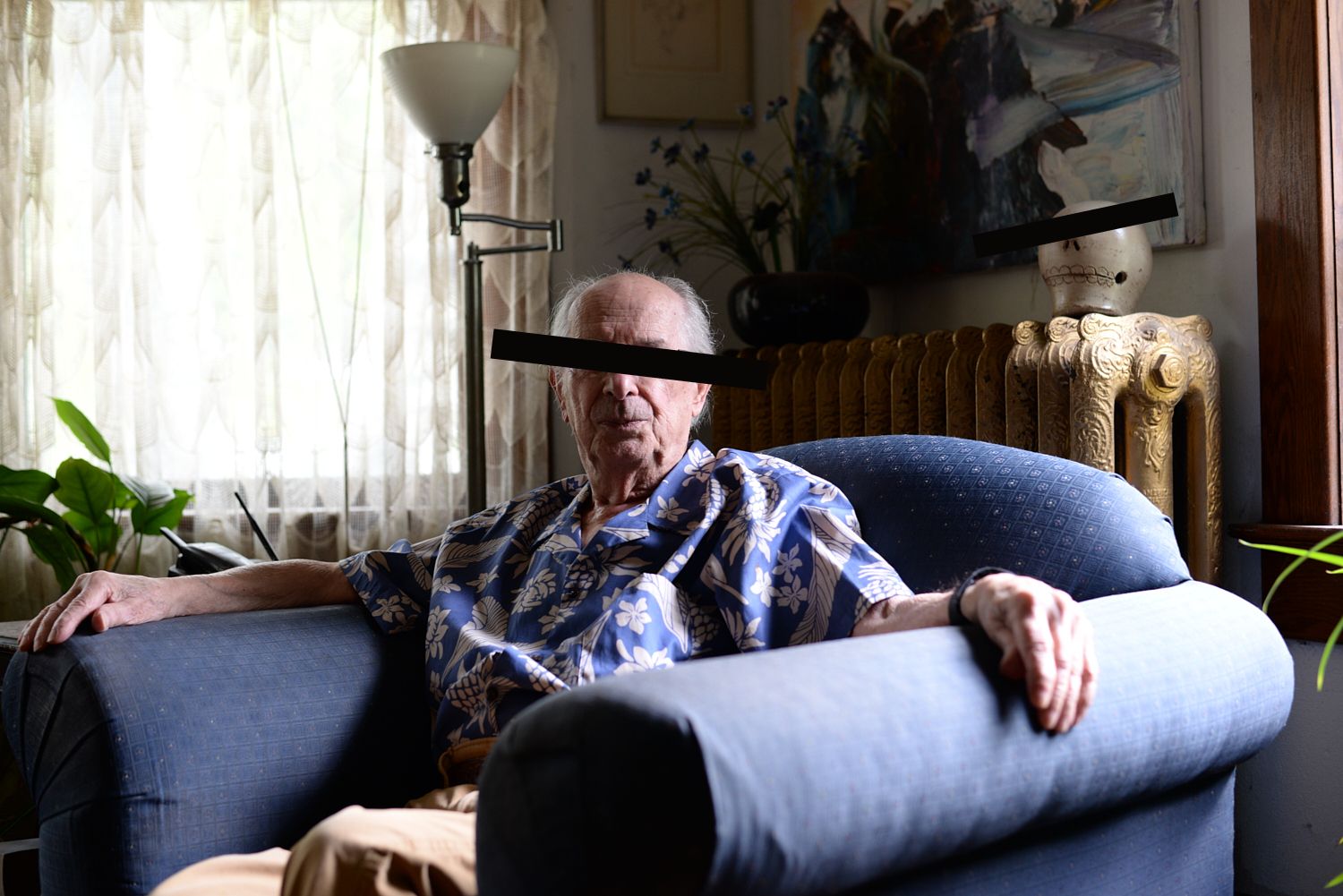
Cristian [Looking around the room] Yeah, like the light is really nice in here and everything.
Dennis: Today I’ve got the blinds halfway up. Usually, they’re down because I try to keep the sun out. As much as possible.
Cristian: [Gesturing to the front windows, completely obscured by trees] Your trees have overtaken. There can’t be too much sun that gets through there…
Dennis: Oh, it does. It comes in through the side and a lot of sun in the evening. We used to have a huge willow on the side. One day I got up, looked out the side window, and said, ‘for Christ’s sake, the trees are really getting full.’ Turns out the willow had fallen over in a rainstorm onto the house, you know, and we had to get rid of it. Doris planted it when it was this tall. We didn’t know at the time she planted it too shallow. Then it grew taller than the house and just couldn’t take it–the huge rainstorm winds, the ground got soft, and eventually, it came onto the house. Same with those [pointing out front.] We didn’t know how to plant them. She just stuck them in the ground. So these have grown to a point where they’re probably dangerous. But as long as they don’t fall on the house or fall onto anybody’s car out there, it’s alright.
[We go into a different room to talk about his drawings again]
Dennis: I started drawing when I was traveling and couldn’t carry around the large steel sculptures. And, I wasn’t interested in doing the sculpture anymore because they got to be pretty awful. Just creepy. Well, and I got too good at it also. There was no challenge. [Pointing to an assemblage] This is the only political one I’ve ever done. Or, topical, I would say.
Cristian: What is that?
Dennis: Well, I won’t tell you anything about that. You just gotta look… the whole thing about it is a mystery. I know what it all means, I know what the title means, I know what it’s all about. If you look at it and studied it, you can figure some of it out, sure…
Cristian: What’s the title?
Dennis: The title is the initials “B” “R,” the division sign, and then, 25. [He laughs.]
Cristian: Yeah, that’s pretty opaque. Did Doris’ [Dennis’ late wife] love of books influence the text in your work?
Dennis: I don’t think so. What I love is the lettering. It started way back with markers. There is just something so definite and final about their mark. It probably comes out of my studying architecture.

Cristian: People need to see your work.
Dennis: It’s very important to me when I’m doing my work–how I’m doing it, when I’m doing it–I’m really enjoying it. But when I’m done with it, I’m done with it. I kinda lose interest in it. Even though I don’t mind having it seen, and I would like to have it seen, but if it isn’t seen it doesn’t make any difference to me. Having done it is what I do.
Cristian: That sounds like a true artist.
Dennis: And a lot of this stuff is made with non-archival materials.
Cristian: Does that ever worry you?
Dennis: No, no. Because if someone complains about it I’ll say its “patina.” I just didn’t have the money to buy expensive materials, or I was working so fast. I didn’t bother to think about how I was using materials, like newsprint or stuff like that. Rubber cement. Rubber cement was one of the worst things I ever used. It hardens and things do come off. But I was using rubber cement because I liked working quickly and I didn’t want to wait for the glue to dry before I did the next step. If I knew what the next step was going to be. It was also a tool that designers used.
Cristian: My father was a designer, and there was this toxic smell in the house when he used it. I have fond memories.
Dennis: Yeah, I do remember when the kids were drawing, with markers and stuff. And I’d walk into the room when they were working and oh my god, no wonder everybody got into drugs, you know, because Jesus, it was so intense.
Dennis: You ever seen those? Those are my pig pieces. Are you still recording? How those pigs came about is there was a variety store in Wausau. I went down into the basement where they were selling the cheap stuff. And there was this counter where these little plastic pigs were piled. Just hundreds and hundreds and hundreds of ‘em. Just piles of them! And they were a penny a piece, penny a pig. So I started buying them, and I would give them as gifts. I would put them in people’s pockets when they wouldn’t notice. I would put them on chairs. I would leave them in restaurants, on plates, everywhere, because I had hundreds of them! And then I started putting them in sculpture. So, that all came about because of an object.
Cristian: So the pigs didn’t necessarily have a meaning beyond that…
Dennis: Just something to look at. Well, that is an explanation that I gave these two sisters when they asked me, well, what is your work all about? And I just said, I make things that you look at.
Dennis: [Pointing at two assemblages] That top one. That’s based on my being angry with having to come back from California. I really loved it out there. I couldn’t work it out to get the whole family out there. Los Angeles, a place I’m sure you could only be there if you were young. And that lower one is in part of my being angry about Doris storing all sorts of crap in the house. But, I needed that. I was, well, you would appreciate it, a very Scandinavian type of guy. Like I had one chair. But then I got hooked up with Doris… Doris had so much luggage, ghosts, and baggage, you know, physical, connected with her. And I was always angry about it, but it did have an effect on me and it did influence the things that I do.
Cristian: You and Doris meet in school?
Dennis: Yeah, in design. She was an English major, who graduated from Loyola. She wound up substituting in some really tough neighborhood schools on the south side of Chicago. She was a very courageous woman. She was teaching art and knew nothing about art. So, she came to the Art Institute to learn some things and we met in design class. She was a pretty fearless lady.
You know, I was kinda a bum. A well-to-do bum. And, I don’t think there was anything cooking whatsoever in me in connection with art. I went to school to study design. So I could have a nice apartment. And then next thing you know I was looking at a sculpture, waiting to register for design, and when I got to the front I registered for sculpture.
